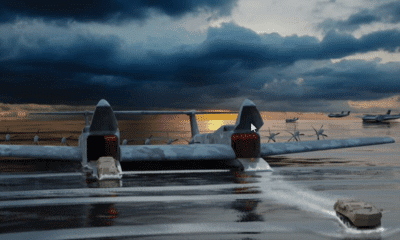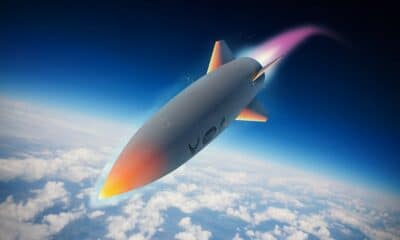Aerospace
Sikorsky And DARPA’s Autonomous Black Hawk® Flies Logistics And Rescue Missions Without Pilots On Board
Autonomous Black Hawk Flies Logistics And Rescue Missions Without Pilots On Board

Sikorsky and the Defense Advanced Research Projects Agency (DARPA) have successfully demonstrated to the U.S. Army how an unmanned Black Hawk helicopter flying autonomously can safely and reliably perform internal and external cargo resupply missions, as well as rescue operations.
The flights, which were conducted on Oct. 12, 14, and 18, as part of the U.S. Army’s Project Convergence 2022 (PC22) experiment, demonstrate how current and future piloted utility helicopters could one day fly complex missions in a low-crew or autonomous mode. In particular, in low visibility or contested environments, this would give Army commanders and aviators greater flexibility in how and when to use aircraft and pilots.
In an effort to significantly increase the efficiency and safety of rotary and fixed-wing aircraft, Sikorsky and DARPA are collaborating to develop autonomy technology. Aircrew Labor In-cockpit Automation System, a DARPA project, is built around Sikorsky’s autonomy system, also known as MATRIX™ technology.
The Sikorsky and DARPA team demonstrated during PC22 Technology Gateway how the optionally piloted Black Hawk helicopter with no humans on board can resupply troops with an external load, reroute mid-flight to evacuate a casualty, and deliver a large quantity of blood product unharmed by flying low and quickly above ground level and using the terrain to mask its signature.
India acknowledges Argentina’s interest in Tejas fighter aircraft(Opens in a new browser tab)
To begin the flight demonstrations, pilots flew and landed the Black Hawk aircraft, then activated the MATRIX system to give full control to the flight computer. When the pilots exited, the helicopter autonomously completed the following mission demonstrations:
- Long-endurance Medical Resupply: The Black Hawk aircraft flew 83 miles while loaded with 400 units of real and simulated blood – totaling 500 pounds. On reaching 40 miles from its initial take-off point, the helicopter descended into a valley as low as 200 feet above ground level at 100 knots.
- Cargo Delivery and Casualty Evacuation (combined mission): The helicopter lifted off with a 2,600-pound external load attached to a 40-foot sling, and flew at 100 knots for 30 minutes toward a designated landing zone. While in flight, the helicopter was redirected, simulating a scenario in which a threat needed to be neutralized near the primary landing site.
The second batch of uninhabited Black Hawk flights this year were the PC22 demonstrations. Sikorsky and DARPA will continue to work toward the transition of this technology for commercial applications like firefighting, cargo, and urban air mobility as well as military operations like casualty evacuation, logistics and medical resupply, and aircrew support and operations.

Aerospace
Indigo will soon launch Air Taxi Service in India

InterGlobe Enterprises, the parent brand of IndiGo, is set to revolutionize travel in India with its upcoming air taxi service.
Scheduled for a potential launch in 2026, this innovative venture promises a seamless journey for passengers between two bustling hubs. Delhi and Gurgaon in Haryana. The forthcoming service is projected to revolutionize the daily commute, offering passengers a swift aerial journey covering the distance in a mere 7 minutes.
This remarkable efficiency contrasts starkly with the conventional 90-minute drive, underscoring the immense time-saving potential for commuters. The anticipated fare, ranging from Rs 2,000-3,000, makes this innovative mode of transport not only swift but also remarkably competitive in pricing.
At the heart of this ambitious endeavor lies a strategic partnership with Archer Aviation, a pioneer in electric vertical takeoff and landing (eVTOL) aircraft technology. Under this collaboration, Archer will supply 200 state-of-the-art eVTOL aircraft, representing an investment of US$ 1 billion. These cutting-edge aircraft, capable of accommodating up to four passengers alongside the pilot, epitomize the future of sustainable air travel.
Powered by six battery packs, Archer’s eVTOL aircraft boast rapid charging capabilities, enabling a swift turnaround between flights. With a charging time of just 30-40 minutes, these eco-friendly aircraft ensure minimal downtime, maximizing operational efficiency.
Similar services are anticipated to be introduced by the joint venture in Bengaluru and Mumbai as well. Nevertheless, the service rollout period has not yet been made public by the company. Next year, it is anticipated to get its certification. Following this, the company will start the certification procedure with the Directorate General of Civil Aviation (DGCA).
Aerospace
Which is bigger 777x or 787 aircraft ?

The 777X is a new series of the Boeing 777 family and is designed to be larger and more efficient than its predecessor. It features two variants: the 777-8 and the 777-9, being the larger of the two.
The Boeing 777X emerges as the larger sibling within the Boeing family, representing a significant leap forward in both size and efficiency. Comprising two variants, the 777-8 and the 777-9, the latter takes the crown as the larger of the two. With its expansive fuselage and impressive wingspan, the 777X is tailored for long-range journeys and boasts a substantial passenger capacity.
On the other hand, the Boeing 787, affectionately known as the Dreamliner, occupies a niche in the market as a smaller yet formidable aircraft designed for medium to long-range flights. Its distinguishing feature lies in its composite fuselage, a technological marvel that renders it lighter and more fuel-efficient compared to conventional aluminum counterparts. The Boeing 777X is larger than the Boeing 787 aircraft.
When it comes to passenger capacity, the 777-9 reigns supreme, typically accommodating a sizeable contingent of 400-425 passengers in its standard configuration. In contrast, the 787, with its more modest dimensions, typically carries between 240-290 passengers, depending on the variant and layout.
One of the remarkable innovations introduced with the 777X is its folding wingtips, a feature designed to address the logistical challenges of accommodating such a large aircraft in conventional airport gates. These folding wingtips enable the 777X to retract its wings, allowing it to fit into gates designed for smaller aircraft while still reaping the benefits of an extended wingspan during flight, thereby enhancing fuel efficiency and operational flexibility
Aerospace
China Secures Production Certificate for Mass Production of Pilotless eVTOL Aircraft

The first passenger-carrying pilotless electric vertical takeoff and landing (eVTOL) aircraft in the world, the EH216-S, has received the Production Certificate for its eVTOL aircraft from the Civil Aviation Administration of China (CAAC).
This is a significant milestone for EHang Holdings Limited, the leading UAM technology platform company in the world. This outstanding accomplishment is another big step towards mass manufacturing for the eVTOL aircraft and the ensuing commercial operations, building on the ground-breaking acquisition of the Type Certificate and the Standard Airworthiness Certificate for the EH216-S.
The PC is a crucial certificate that the aircraft maker receives from the CAAC, the country’s aviation authority. By obtaining this certificate, EHang has demonstrated that it has set up a quality management system for mass production that satisfies the airworthiness regulation standards set forth by the CAAC, and the company has been given permission to continue producing mass quantities.
It is also a strong guarantee of the calibre of the goods made by EHang. Raw materials, supplier management, manufacturing organisation, production quality control, aircraft pre-delivery test, after-sales repair and maintenance, etc. are all included in the mass production quality management system for the EH216-S.
To ensure that every aircraft and its components that roll off the production line strictly adhere to the approved type design and safety requirements, the system sets clear guidelines and documentation for every step in the production procedure. This ensures comprehensive traceability and safety control.

























